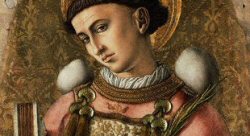 From the blog of Fr. Zuhlsdorf - a post about the sometimes unrealistic demands placed on a parish priest. You can view the full post HERE, and read the content of a "chain letter" he posted below:
From the blog of Fr. Zuhlsdorf - a post about the sometimes unrealistic demands placed on a parish priest. You can view the full post HERE, and read the content of a "chain letter" he posted below:The "Perfect" Priest
The results of a computerized survey indicate the perfect priest preaches exactly fifteen minutes. He condemns sins but never upsets anyone. He works from 8:00 AM until midnight and is also a janitor. He makes $50 a week, wears good clothes, buys good books, drives a good car, and gives about $50 weekly to the poor. He is 28 years old and has preached 30 years. He has a burning desire to work with teenagers and spends all of his time with senior citizens.
The perfect priest smiles all the time with a straight face because he has a sense of humor that keeps him seriously dedicated to his work. He makes 15 calls daily on parish families, shut-ins and the hospitalized, and is always in his office when needed.
If your priest does not measure up, simply send this letter to six other churches that are tired of their priest, too. Then bundle up your priest and send him to the church on the top of the list. In one week, you will receive 1,643 priests and one of them will be perfect. Have faith in this procedure.
One parish broke the chain and got its old priest back in less than three weeks.
The results of a computerized survey indicate the perfect priest preaches exactly fifteen minutes. He condemns sins but never upsets anyone. He works from 8:00 AM until midnight and is also a janitor. He makes $50 a week, wears good clothes, buys good books, drives a good car, and gives about $50 weekly to the poor. He is 28 years old and has preached 30 years. He has a burning desire to work with teenagers and spends all of his time with senior citizens.
The perfect priest smiles all the time with a straight face because he has a sense of humor that keeps him seriously dedicated to his work. He makes 15 calls daily on parish families, shut-ins and the hospitalized, and is always in his office when needed.
If your priest does not measure up, simply send this letter to six other churches that are tired of their priest, too. Then bundle up your priest and send him to the church on the top of the list. In one week, you will receive 1,643 priests and one of them will be perfect. Have faith in this procedure.
One parish broke the chain and got its old priest back in less than three weeks.





.jpg)
.jpg)





































